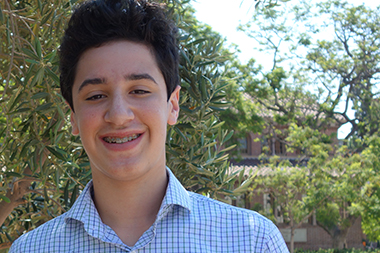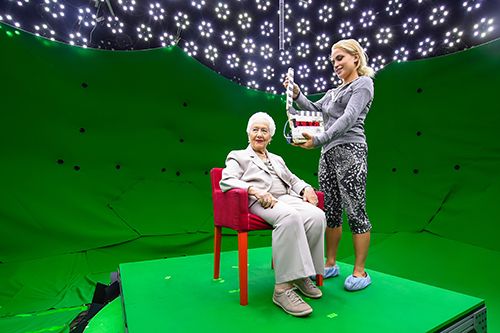
Dov Ratner
During his two-week internship at USC Shoah Foundation this summer, Ohio 10th grader Dov Ratner is testing the latest New Dimensions in Testimony interviews by asking the computer system questions for each survivor and noting the accuracy of the responses he receives in return.
But there’s one interviewee he doesn’t need New Dimensions in Testimony to have a conversation with: Holocaust survivor Renee Firestone, his great-grandmother.
Born in Czechoslovakia, Renee survived Auschwitz at age 21 but lost several family members, including her parents and sister. She married and immigrated to the United States, where she became a fashion designer and, later, a prolific speaker about the Holocaust and her survival.
Firestone recorded her testimony for USC Shoah Foundation’s Visual History Archive in 1994. In 2015, she also sat for a weeklong interview on USC Institute for Creative Technologies’ 360-degree light stage for USC Shoah Foundation’s New Dimensions in Testimony project. Her New Dimensions in Testimony interview is interactive, meaning audiences will be able to ask her recorded image questions about her life before, during and after the Holocaust and see her responses in real time.

“She doesn’t talk about [the Holocaust] as much as people would think, but I know I can ask her. She would describe everything, how it affected her, what it felt like,” Dov said. “I find it fascinating. All Holocaust survivors’ stories are so complex and every little decision mattered in the long run. It’s unbelievable how they survived and stayed strong.”
Since he first visited USC Shoah Foundation in January and began his internship last week, Dov said he has loved working on New Dimensions in Testimony. He’s testing several interviews to ensure the system returns accurate interviewee responses for any question a viewer might ask – and the survivor he started with on his very first day was Renee.
According to Dov, interacting with Renee’s interview is not much different from asking her questions in person.
“It was similar because the answers are the same as what she would say in real life, which was cool,” he said.
It is vital that survivors’ stories are preserved forever through technology like New Dimensions in Testimony, Dov said, so that students and the public are excited to keep learning about it. Having a conversation with a survivor can be more impactful on someone than just learning about historical events in a classroom.
“When you get to be face to face and just ask them straight out ‘How did this affect you? Why is this this way?’ it’s more impactful and it’s going to resonate more with the person,” he said. “There’s so much to learn from the Holocaust and all these survivors.”